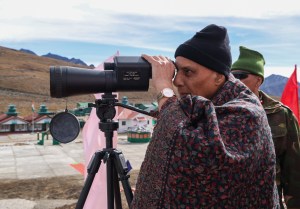Indian Defense Minister Rajnath Singh’s message to China could not have been any louder on the festival of Dusshera, which marks the victory of good over evil in Hindu Mythology.
Rajnath Singh chose forward posts in Arunachal Pradesh, a state repeatedly claimed by China, to celebrate the festival by worshipping weapons and paying homage to Indian soldiers killed in action during the 1962 India-China war.
This is the defense minister’s first visit to Arunachal Pradesh after the Indian and Chinese troops clashed here in December 2022.
Singh celebrated Dusshera with troops and performed ‘shastra puja’ (weapons worship) at Tawang, a town perched at 10,000 feet above sea level and the seat of India’s largest Buddhist monastery.
The town, along with the entire state of Arunachal Pradesh, is coveted by China. Of all the disputed areas in Arunachal Pradesh, Tawang remains high on China’s list of claims.
Tawang was among the areas taken during a brief war in 1962 that ended in a massive defeat for India. In December 2022, Tawang hit the headlines as Indian and Chinese troops engaged in a scuffle.
Singh had informed the Parliament that “on December 9, 2022, PLA troops tried to transgress the LAC in the Yangtse area of Tawang Sector and unilaterally change the status quo.”

The Defense Minister added: “The ensuing face-off led to a physical scuffle in which the Indian Army bravely prevented the PLA from transgressing into our territory and compelled them to return to their posts. The scuffle led to injuries to a few personnel on both sides.”
The two sides agreed to eschew firearms in their conflict that has been occurring with increasing frequency since the Galwan Valley clash in 2020. But this doesn’t dissuade the troops from both sides from using canes, clubs, and other weapons and inflicting injury on the adversary’s soldiers.
During his visit to the forward posts in Arunachal Pradesh on October 24, Singh carried out a “first-hand on-ground assessment of the operational preparedness of the Armed Forces there.”
Given the current global scenario, Singh asserted that there is no option but to bolster the country’s security apparatus, underlining that the Indian government is making all efforts to strengthen the nation’s military prowess through indigenous production of defense equipment. He visited the Tawang War Memorial, where he offered tributes to the Indian soldiers killed in action during the 1962 war.
The Tawang monastery is key for China as it was here that the present Dalai Lama stayed for weeks after escaping China in 1959. Beijing sees it as an essential site in the history of Tibetan resistance to Chinese rule. If Tibetan resistance rises again, China expects Tawang to emerge as a critical center of dissent.
Former Indian Army Chief MM Narvane told the EurAsian Times: “It is good. We must visit border areas to establish our writ, especially in disputed areas.”
Former Indian Army chief MM Narvane told the EurAsian Times: “It is good. We must visit border areas to establish our writ, especially in disputed areas.”
India Consolidating Arunachal Pradesh
Following the December 2022 clash, India launched a “vibrant villages” scheme in February 2023. Under the scheme, the Indian government will be pumping in US$600 million to develop villages adjacent to the Chinese border, underscoring its resolve to consolidate defenses on its side of the Himalayan frontier.
Indian Home Minister Amit Shah visited Arunachal Pradesh days after China released a map renaming 11 places to launch the Vibrant Villages scheme in Kibithoo, about 15 kilometers south of the de-facto India-China border.
India also promotes tourism in Arunachal Pradesh, with hotels, restaurants, and homestays springing up in Tawang and surrounding areas.
Shah’s visit drew a swift reaction from China, with Foreign Ministry spokesman Wang Wenbin saying, “The activity of the senior Indian official in Zangnan violates China’s territorial sovereignty and is not conducive to peace and tranquillity in the border areas. We are firmly against this.”
The BBC quoted a retired senior colonel in the Chinese People’s Liberation Army: “It’s not just the Tawang sector. The entire Arunachal Pradesh [state], which we call southern Tibet, has been illegally occupied by India — it’s non-negotiable.”
India’s Dilemma: To Court Or Counter-Balance China
In the past few months, India has been playing on offensive vis-a-vis China. India-China disputed boundary, also known as the 3,488 km LAC (China claims to be around 2,000 km long), has been largely peaceful since the 1962 war.
Since the Doklam confrontation between the two countries in 2017, the border has been simmering, and the relations between the two countries have been strained. India has been alarmed by China’s unilateral attempts to change the status quo along the disputed boundary.
On August 10, 2022, India flew the Dalai Lama in an Indian Air Force helicopter from Leh, the capital of Ladakh, to the remote Himalayan village of Lingshed. India’s Ministry of Defense shared photographs of the Tibetan spiritual leaders with IAF officers at the Leh air station and disembarking from the helicopter at a helipad at Lingshed, much to the Chinese chagrin.
The one-month-long visit came when India and China deployed at least 50,000 soldiers at the Line of Actual Control (LAC) in Ladakh, substantially enhancing their weaponry and defense systems.
Last year, Indian Prime Minister Narendra Modi closed the distance his administration has maintained from Tibetan Spiritual Leader Dalai Lama to ease out its courtship with China.
He greeted the Dalai Lama on his 87th birthday on July 6, riling up China. Reacting sharply, Beijing said India “needs to fully understand the anti-China and separatist nature of the 14th Dalai Lama.”
- Ritu Sharma has been a journalist for over a decade, writing on defense, foreign affairs, and nuclear technology.
- She can be reached at ritu.sharma (at) mail.com
- Follow EurAsian Times on Google News